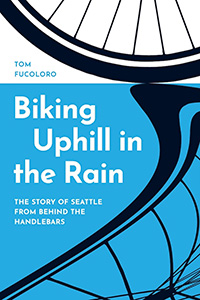Following the exciting passage of JumpStart Seattle revenue package, which levies a tax on high-end salaries at large companies to fund an array of COVID-19 recovery and affordability programs, the details of the city’s plan for Proposition 1 to renew the Seattle Transportation Benefit District (“STBD”) is a splash of cold water. While JumpStart Seattle is a bold an progressive measure to invest in the community in new ways, even a successful Prop 1 will be a cut in transit service.
The 2020 Prop 1 measure’s 0.1% sales tax is expected to bring in about half the funding of the previous iteration that voters passed overwhelmingly in 2014. And its primary leaders both opposed JumpStart Seattle. City Council Transportation Chair Alex Pedersen was one of only two “No” votes on JumpStart Seattle, and Mayor Jenny Durkan has opposed the JumpStart Seattle measure.
However, this shortfall in isn’t really the fault of Councilmember Pedersen or Mayor Durkan. The 2014 measure, which expires at the end of the year, included the same 0.1% sales tax in addition to a $60 vehicle license fee that could largely become illegal if the successful I-976 statewide initiative makes it through the courts. The outcome of that case is still up in the air, so it would likely be unwise to pursue a new measure that assumes the courts will overturn the initiative. And the State Legislature failed to provide any new revenue options for transportation benefit districts during their 2020 session, leaving the city with sales tax as the only option available.
Seattle could increase the sales tax to a maximum of 0.2%, but the idea of increasing the most regressive tax source we have at a time when people and small businesses will be struggling financially also seems unwise. So we’re left with simply renewing the sales tax portion of the 2014 measure, and then figuring out how to cut the transit budget even further. It’s a stop-gap measure to try to ease the pain, not a visionary measure to improve how people in Seattle get around.
There was also hope that King County would run a similar ballot measure county-wide, but the county declined to do so. This leaves Seattle to try to save what it can using a limited city-only measure.
There are so many things that are frustrating about this situation, but the biggest frustration is that the STBD was working. In 2015, only a quarter or households in the city were within a short walk of a bus or train that arrived every ten minutes or less. In 2019, that figure was up to 70%, largely due to STBD-funded bus hours. It’s likely that number will go back down under a smaller STBD. And the measure didn’t just add hours, it also invested in capital improvements like bus lanes so that buses that are running are faster and more reliable.
STBD will expire at the end of 2020. This measure has drastically expanded service and brought a 10 min walk to 10 min service to 70% of households in Seattle, along with other affordability & equity programs. It was approved by 62% of the vote. (2/16) https://t.co/lEYzOIxu2I pic.twitter.com/FicLcdgGWg
— Transportation Choices Coalition (@TranspoChoices) July 7, 2020
The ORCA Opportunity program, an initiative led by high school students, has been very successful at getting free transit passes to Seattle Public School students and low-income seniors. And when more people had these passes, they took more trips, saving each user and family hundreds of dollars per year while certainly decreasing the number of trips by car.
 The good news is that the city plans to continue fully funding the ORCA Opportunity program if voters approve this measure in November. The bad news is that many of those card holders will have fewer buses to ride due to service cuts and will have to wait longer for reliability improvements like bus lanes and bus-prioritizing traffic signals.
The good news is that the city plans to continue fully funding the ORCA Opportunity program if voters approve this measure in November. The bad news is that many of those card holders will have fewer buses to ride due to service cuts and will have to wait longer for reliability improvements like bus lanes and bus-prioritizing traffic signals.
Voters approved the 2014 STBD measure by nearly 25 percentage points (62.43-37.57). So it is extremely frustrating that here we are with transit needs greater than they’ve ever been talking about passing a measure smaller than the one voters overwhelmingly approved six years ago.
But while Seattle doesn’t have a lot of options when it comes to revenue, it can choose where the funds go. Here are the priorities listed in an SDOT Blog post:
- Provide safe, efficient, and frequent transit for all Seattleites, particularly our essential workers fighting against this global pandemic.
- Preserve a robust, connected transit system in Seattle that centers equity
- Make investments that address acute mobility needs in areas like West Seattle
- Invest in ORCA Opportunity for students and Low Income Access program for our vulnerable
- Maintain the voter-approved 0.1 percent sales tax to provide needed resources for transportation investments and ensure continuity of critical services despite financial restrictions caused by I-976 and COVID-19
The SDOT post also notes that the proposal could help improve transit service for West Seattle as the neighborhood deals with the bridge closure:
Whether it is by bus or boat, we know that transit is the most efficient way to move people to and from West Seattle, and reduce the cut-through traffic in those communities most acutely impacted by the High-Rise Bridge’s closure. With new funding, we will be better positioned to deploy the transit options that help travelers continue to access the goods, services, and activities they want and need. This, too, is critical to our recovery.
It is vital, however, that these funds go to transit and not to the bridge or other road work for cars. Here’s the wording in the current version of the legislation (PDF) regarding a $6 million pool of funds designated for COVID-19 and West Seattle Bridge mitigation:
Up to 6 million dollars of the Proposition 1 revenues maybe used annually to support emerging mobility needs related to COVID-19 response and recovery, and closure of the West Seattle High Bridge. Such investments could include transit service, speed and reliability improvements and Transportation Demand Management strategies described in the community-driven Reconnect West Seattle plan.
The entire package is only expected to bring in $20 to $30 million per year (and likely on the low end for the first couple years as sales tax will still be lower than usual due to the outbreak and all the related business closures). So $6 million per year out of maybe $20 million is a lot. The Council may want to make sure the uses of these funds are more explicit and transit-focused. It would suck if a quarter of Seattle’s only transit-specific measure just went to bridge design consultants or were used as matching funds for a grant. We need this money to do on-the-ground transit service and programming. The city will certainly need to find a source of funds for West Seattle Bridge work, but that can’t come out of this limited and already-decreased transit-focused measure.
Prop 1 will need to pass, but it’s not going to be enough. We need more transportation funding options that are funded by more secure, reliable and progressive sources. I don’t know exactly what that looks like, but all options need to be on the table. And Seattle will need the state and county to do their parts, too. It is exhausting, inefficient and unsustainable to fight every couple years to win transit and transportation ballot measures. We fought for two Transportation Benefit District measures in 2014 (county lost, Seattle won), the Move Seattle Levy in 2015, Sound Transit 3 in 2016, and now a Transportation Benefit District again in 2020. Every single time, people of Seattle say loud and clear that we want to invest in transit, walking, biking and basic street maintenance. It shouldn’t be this hard for Seattle to fund its own popular transportation needs.










Comments
One response to “Mayor proposes smaller transit-funding measure to replace expiring 2014 tax”
“Seattle could increase the sales tax to a maximum of 0.2%, but the idea of increasing the most regressive tax source we have at a time when people and small businesses will be struggling financially also seems unwise.”
Oh come on. This is a tax of 0.1%. It does not apply to rent or food. So where is the hardship? Really, I’ve thought of some scenarios, where the overall tax rate does take a hit, but this tax — as tiny as it is — would be practically nothing:
1) A single mother buys $100 worth of clothes for her kid. She pays an extra dime in tax.
2) A large family has to buy a new washing machine and a new dishwasher. They spend $1,000 bucks at Sears, and are out an extra dollar.
3) Someone buys a brand new car because they feel like they need to. They pay 20 grand for the thing. This costs them an extra 20 bucks.
This is such a tiny tax, and yet without it, it hits people hard. The very people who carried doctors and nurses to their jobs during the pandemic will be laid off. They saw their colleagues die in the line of duty, yet we can’t muster a few extra pennies so they can keep their job.
This is all politics. Durkan still has dreams of higher office, and calling herself a “tax moderate” helps her with the rest of the state. Pedersen opposed the last two transit packages. I don’t mean he voted against them, I mean he actively campaigned against them. Not because of some issue with the spending, but merely because he didn’t want to raise taxes.
We all know that sales taxes are regressive. But passing a regressive tax is better than cutting back on services (oh, and a car tab tax is also regressive). Given the fact that this tax doesn’t apply to two essentials (food and shelter) the best option is to propose a 0.2% tax.